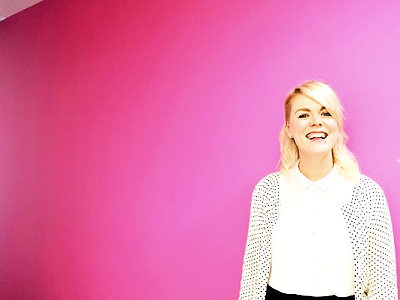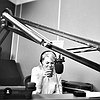Name: Cheri Amour
Nationality: British
Occupation: Writer/broadcaster/pop fan
Current project: Presenter on The Other Woman show on Soho Radio
Recommendation: Sleater Kinney, The Woods. An outstanding feat of production and song-writing and a firm number one in my all-time favourite bands list. The interplay between Carrie Brownstein’s skronking guitars, Corin Tucker’s caterwaul and Janet Weiss’ command of the drums is totally mesmerising / Sarah Waters, Fingersmith. I toyed between Donna Tartt and Waters, both of whom I love for their dark and twisted tales of class, courage and catastrophe. This book is set in Victorian-era London (classic Waters) and traces the street-smart steps of Sue, a petty-thief lured to pose as a chambermaid of a wealthy mistress only to discover something that will turn her world upside down.
Website/contact: Read Cheri's work and get in touch by visiting her website cheriamour.co.uk
When did you start writing about/reporting music - and what or who were your early passions and influences? What is it about music and/or sound that drew you to it?
I turned to music journalism when I was living abroad in Paris. I had moved over there for my degree and had (reluctantly) put a hiatus on the band I was playing in, so I was looking for other creative outlets. I spotted The Girls Are magazine was looking for foreign correspondents. It was a total win for me as it meant I could use my exotic British background as a journalist (this was all pre-Brexit obviously) to get into lots of touring bands’ gigs and nab interviews with artists I wouldn’t have stood a chance securing back home in England. Meeting Melissa Auf Der Maur ahead of her Trabendo show was a huge highlight and I’ve since interviewed her for the print version of the magazine, thanks to her kind words and praise of our original knees up.
I’ve always been a strong advocate of women in music. I remember in my early teens pouring over my Mum’s Blondie records and when her partner at the time introduced me to the Brit-pop snarl of Elastica, I was smitten. Riot grrrl came a little later - a well-needed antidote to my lovelorn romanticism for long-haired boy bands - and remains my biggest influence to date. I recently wrote about Kathleen Hanna celebrating the big 5-0 and her incredible legacy in pushing girls to the front in terms of representation and recording for Scottish greats, The Skinny.
For most, originality is first preceded by a phase of learning and, often, emulating others. What was this like for you? How would you describe your own development as a reporter and the transition towards your own style? What’s the relationship between copying, learning and your own creativity?
I came into writing in a sort of roundabout way as I was writing about bands and women guitarists after being one myself so I felt I had a strong sense of the type of questions those artists wanted to hear rather than the tired old tripe about “What it means to be a woman in the music industry?” That being said, the editorial team at The Girls Are were a beacon in terms of focus and drive for pitching and creating content. The Ed-In-Chief, in particular, really pushed me and I rose through the ranks from Albums and Live Editor tackling say 200-300 word record reviews into two-page investigative features referencing and weaving in a number of sources.
I’m also still very much that bookish school geek so I made an effort to learn as much as possible, sitting my NCTJ sub-editing course at Brighton Journalist Works in the summer of 2014. This sat well with my penchant for a pun headline and also taught me the ropes in terms of printer’s marks and flowing copy into a magazine spread.
What were your main challenges as a reporter when starting out and how have they changed over time?
Music journalists aren’t exactly few and far between and there are a lot of people very capable of writing the kind of record and live reviews I was dishing up at the start. I think that’s why, serendipitously, it worked out well to carve a space for myself in an area of music journalism rather than Johnny Five Hats. I wanted to write about things that shifted the perspective slightly, offered up a different gaze to the traditional reporting on the scene and hopefully, shine a light on independent and non-conforming artists who otherwise wouldn’t be represented online or in print.
The focus towards more diversity in music has shifted over time and there are tons of excellent indie magazines flying this flag for women and non-binary artists; She Shreds, Tom Tom, Girl Gang in the States. But when TGA first started out, the primary goal - quite remarkably - was to become defunct. When the other mainstream publications were picking these artists up for the front covers rather than some sort of ‘women in music’ special, our work was done.
How do you see the role of music journalism in the creative process? Should it amplify public taste, distinguish the good from the bad, inform, promote artists, or, as Howard Mandel put it, “illuminate, educate and entertain” readers?
I think Howard’s probably closest to the mark. For me, I’d like to see music journalism using a tastemaker approach to serve up new recommendations and rising artists or dive into a retrospective of proper indie heavyweights. The Line of Best Fit’s long-reads do a great job of that, similarly The Guardian (Laura Snapes’ recent number with Robyn was a gem). Equally though, I’m happy to read about going on a first-date with Andrew WK (thanks, Noisey). There’s always room for pop culture frivolity if executed well. TGA dedicated its whole back pages to paper dolls of Gwen Stefani and Beyonce and there’s something entertaining and comfortingly nostalgic about that.
Whom do you feel your obligation to – the artists, the readers, the publication you're writing for?
What a good question. Artist first and foremost, as that would drive my decision about whether I will cover or pitch for them. The other two are sort of entwined. One of my biggest vices is print magazines so my stacks of subscriptions should be testament to my research into a publication’s tone of voice, house style and the types of features they commission for their readers. My pitches will always be tailored to that so, for example, if I know I want to go hard on an album’s technical construction and the equipment used, She Shreds would probably be a good bet for the guitar gear side of things. A lot of lifestyle publications I write for often come with a theme to their issue so that gives me a good steer for my feature as well.
What are the most important conclusions you've drawn from the changes in the publishing landscape? How do they affect journalism in general and your own take in particular? What role does social media play for your approach?
There’s obviously the longstanding opinion that “print is dead” but, after a year of freelance pitching, it feels quite the opposite. Considerably more value is placed on print publication content, potentially as it exists as a tactile, evergreen feature far longer than any kind of Buzzfeed listicle will do on an online site. A lot of my pitching focus is dedicated to print magazines for this reason, particularly for the curation and art direction that goes into these pieces and the ability to be able to commission accompanying bespoke illustrations or photography.
It’s funny actually as I’ve been working in digital concurrently since I graduated back in 2012 (yikes) so I’ve seen the evolution of online media and also earnt my digital chops in an award-winning SEO agency when I just moved to London. Social media marketing is such an accessible tool for both speaking directly with independent artists but also when it comes to finding key contacts for pitching to various publications. They’re all on there if you just do a bit of a digging. It’s also a fantastic self-promotion tool although admittedly it has meant I’ve had to streamline the number of cat posts I push out on my Instagram vs link in bios to read more of my work.
How do you make use of technology? In terms of the feedback mechanism between technology and creativity, what do humans excel at, what do machines excel at?
I wouldn’t be able to capture my interviews without it although only at festivals do I find it a little trying at times and have to resort back to old faithful pen and paper. I’ll use a dictaphone for all my face-to-face meetings with artists and obviously transcribe that using something like Trint. I’m a big G Drive fan and a lot of Editors also use this for a collaborative tool (especially for US publications) to feedback on a piece of work and apply suggested edits. There’s the various CMS’ I submit my work into and of course, the other side of promoting it via social media and my website which I built myself using Squarespace.
In terms of tech vs creativity, a voice memo might capture the conversation but it’s going to be a human that adds in the flourishes and details of the way a band holds themselves or the setting we find them in that really sets a piece apart from a Q&A to an immersive experience you can almost see playing out in your head. I try to do that more and more after I leave an interview, just take a few moments to jot down any feelings, behaviourism, funny quirks that might’ve come across to me and then weave those through later in the write up.
Collaborations can take on many forms. What role do they play in your approach and what are your preferred ways of engaging with other creatives, writers and possibly even the artists you're interviewing or working with for a piece?
I’m a very typical ENTJ character so face-to-face is always my preference when it comes to interviewing artists as it brings so much more colour to the piece in terms of the setting and any in-situ anecdotes. I had some time last summer with an artist and I could just sense from her management shuffling in with more press demands that she was being pushed to her limit so the conversation (and resulting feature) was sort of shaped in that direction. Failing that, I’ll always lead a Skype conversation with a bit of an opening question about where they are at that moment or what they can see from a nearby window. Worst-case scenario, a Q&A via email but the preference is always to get stuck into something with a bit more narrative.
Working alongside other creatives, I’m a stickler for planning so love collaborative (and free) tools like Trello to map out plans and projects but also rely heavily on additional bandwidth in my Google Drive for shared video content and suggested edits.



